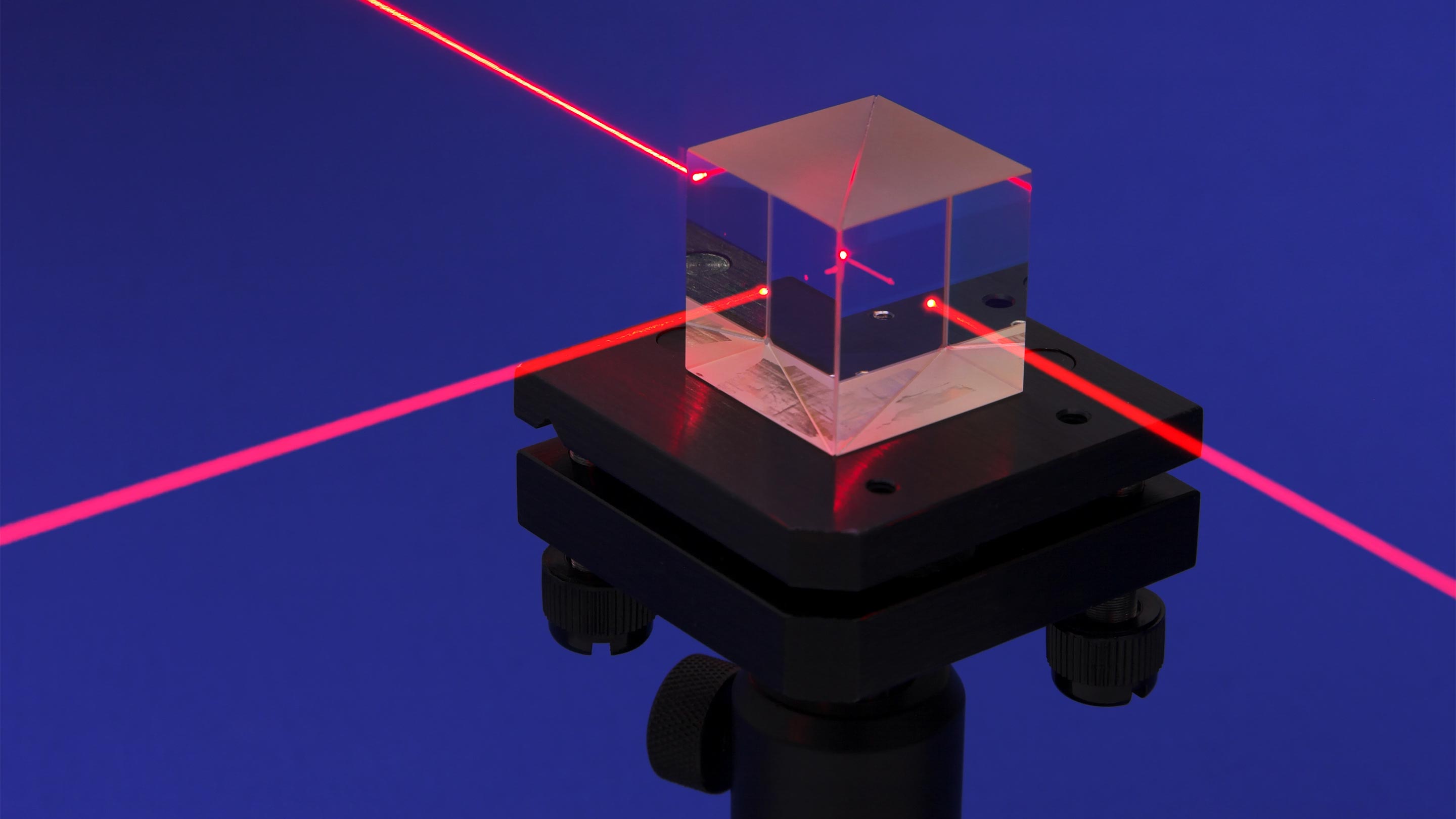A New Tool for Finding Dark Matter Digs Up Nothing

Researchers recently searched for a kind for dark matter that would expand and contract the beam splitter at the heart of a gravitational wave detector.
GIPhotoStock/Science Source
Introduction
Even the strongest gravitational waves that pass through the planet, created by the distant collisions of black holes, only stretch and compress each mile of Earth’s surface by one-thousandth the diameter of an atom. It’s hard to conceive of how small these ripples in the fabric of space-time are, let alone detect them. But in 2016, after physicists spent decades building and fine-tuning an instrument called the Laser Interferometer Gravitational-Wave Observatory (LIGO), they got one.
With nearly 100 gravitational waves now recorded, the landscape of invisible black holes is unfurling. But that’s only part of the story.
Gravitational wave detectors are picking up some side gigs.
“People have started to ask: ‘Maybe there’s more to what we get out of these machines than just gravitational waves?’” said Rana Adhikari, a physicist at the California Institute of Technology.
Inspired by the extreme sensitivity of these detectors, researchers are devising ways to use them to search for other elusive phenomena: above all, dark matter, the nonluminous stuff that holds galaxies together.
In December, a team led by Hartmut Grote of Cardiff University reported in Nature that they had used a gravitational wave detector to look for scalar-field dark matter, a lesser-known candidate for the missing mass in and around galaxies. The team didn’t find a signal, ruling out a large class of scalar-field dark matter models. Now the stuff can only exist if it affects normal matter very weakly — at least a million times more weakly than was previously thought possible.
“It’s a very nice result,” said Keith Riles, a gravitational wave astronomer at the University of Michigan who wasn’t involved in the research.
Until a few years ago, the leading candidate for dark matter was a slow-moving, weakly interacting particle similar to other elementary particles — a sort of heavy neutrino. But experimental searches for these so-called WIMPs keep coming up empty-handed, making room for myriad alternatives.
“We’ve kind of reached the stage in dark matter searches where we’re looking everywhere,” said Kathryn Zurek, a theoretical physicist at Caltech.
In 1999, three physicists proposed that dark matter might be made of particles that are so light and numerous that they’re best thought of collectively, as a field of energy that permeates the universe. This “scalar field” has a value at each point in space, and the value oscillates with a characteristic frequency.
Scalar-field dark matter would subtly alter the properties of other particles and fundamental forces. The electron’s mass and the strength of the electromagnetic force, for example, would oscillate with the oscillating amplitude of the scalar field.
For years, physicists have wondered whether gravitational wave detectors could spot such a wobble. These detectors sense slight disturbances using an approach called interferometry. First, laser light enters a “beam splitter,” which divides the light, sending beams in two directions at right angles to each other, like arms of an L. The beams reflect off mirrors at the ends of both arms, then return to the hinge of the L and recombine. If the returning laser beams have been pushed out of sync — for instance, by a passing gravitational wave, which briefly lengthens one arm of the interferometer while contracting the other — a distinct interference pattern of dark and light fringes forms.
Could scalar-field dark matter push the beams out of sync and cause an interference pattern? “The common thinking,” said Grote, was that any distortions would affect both arms equally, canceling out. But then in 2019, Grote had a realization. “One morning I woke up and the idea came to me suddenly: The beam splitter is exactly what we need.”
The beam splitter is a block of glass that acts like a leaky mirror, reflecting, on average, half of the light that strikes its surface, while the other half passes through. If scalar-field dark matter is present, then whenever the field reaches its peak amplitude, the strength of the electromagnetic force weakens; Grote realized that this would cause atoms in the glass block to shrink. When the field’s amplitude drops, the glass block will expand. This wobble will subtly shift the distance traveled by the reflected light without affecting the transmitted light; thus, an interference pattern will appear.
With the aid of computers, Sander Vermeulen, Grote’s graduate student, searched through data from the GEO600 gravitational wave detector in Germany looking for interference patterns resulting from several million different frequencies of scalar-field dark matter. He saw nothing. “It’s disappointing because if you do find dark matter, that would be the discovery of decades,” Vermeulen said.
But the search was only ever “a fishing expedition,” said Zurek. The scalar field’s frequency and the strength of its effect on other particles (and therefore the beam splitter) could be almost anything. GEO600 only detects a specific range of frequencies.
For this reason, the failure to find scalar-field dark matter with the GEO600 detector doesn’t rule out its existence. “It’s more a demonstration that we have a new tool now to look for dark matter,” said Grote. “We will go on searching.” He also plans to use interferometers to search for axions, another popular dark matter candidate.
Meanwhile, Riles and his colleagues have been searching for signs of “dark photons” in data from LIGO, which has detectors in Livingston, Louisiana, and Hanford, Washington, and its partner, the Virgo detector near Pisa, Italy. Dark photons are hypothetical light-like particles that would mostly interact with other dark matter particles but would occasionally strike normal atoms. If they’re all around us, then at any given moment, they’ll happen to push on one mirror in an interferometer more than the other, changing the relative lengths of the arms. “There will tend to be an imbalance in one direction, just a random fluctuation,” Riles said. “So you try to exploit that.”
Dark photon wavelengths can be as wide as the sun, so any random fluctuations that disturb the mirrors of the interferometer in Hanford would have the same effect at the Livingston detector, nearly 5,000 kilometers away, and correlated effects in Pisa. But the researchers found no such correlations in the data. Their result, reported last year, means that dark photons, if real, must be at least 100 times weaker than previously allowed.
Adhikari proposes that gravitational wave detectors could even find “human-sized” dark matter particles weighing hundreds of kilograms. As these heavy particles flew through the detector, they would gravitationally attract LIGO’s mirrors and laser beams. “You’d see a little bit of a winking in the beam’s power as the particle flies through,” said Adhikari. “The entire L-shape detector is a sort of a net that can get these particles.”
What else could these sensitive instruments catch? Adhikari is developing a novel interferometer at Caltech to look for signs that space-time is pixelated, as some quantum theories of gravity suppose. “That’s always the dream of physicists. Can we measure quantum gravity in the lab?” Conventional wisdom holds that a detector capable of probing such tiny distances would be so big that it would collapse into a black hole under its own weight. Zurek, however, has been working on an idea that could make quantum gravity detectable with Adhikari’s setup or another experiment at Grote’s lab in Cardiff.
In other quantum gravity theories, space-time isn’t pixelated; instead, it’s a 3D hologram that emerges out of a 2D system of quantum particles. Zurek thinks this, too, might be detectable with gravitational wave detectors. Small quantum fluctuations in the 2D space would be amplified when holographically projected into 3D, potentially making waves in space-time big enough for an interferometer to pick up.
“When we started working on this, people were like: ‘What are you talking about? You’re completely nuts,” Zurek said. “Now people are starting to listen.”



